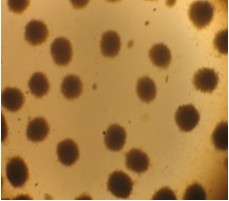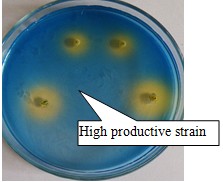The researchers of biophysics department in Institute of Modern Physics, Chinese Academy of Sciences (IMP) obtained a new strain of Aspergillus niger named H4002 (producing citric acid), which is bred by using heavy ions radiation mutation breeding techniques. Fermentation technologies used for this strain to produce citric acid were also obtained in this study.
Compared with the control strain, H4002 had much higher citric acid productivity. It’s fermentation cycle was 53hs, which 10hs shorter than that of control strain, and it’s citric productivity at the end of fermentation was 19%, which was 5g/100ml higher than current production level of domestic industry and was 1.36 times current level. Researchers found that obtaining uniform balls is one of the prerequisites for increasing productivity by sampling the uniform fungal balls during the yield acid period.
Furthermore, the high productive strain grown on the screening plate. The screening plate is 20 ml potato dextrose agar medium supplemented with 0.1% bromocresol green in Petri dish. Strain with higher citric acid productivity can form a bigger yellow circle on the screening plate.
Citric acid is a kind of primary metabolite of organism, and Aspergillus niger is the main fungi in fermentation industry. Citric acid is widely used in food, medicine, and chemical industry, etc. It is one of the largest demands in the international fermentation products market. The strain H4002 and related technology shorten the fermentation cycle and increased productivity, which is the important basis to improve production efficiency, reduce production costs, and enhance the core competitiveness of manufacturers.
This work was supported by the “Western Light” Foundation (Year 2011) of Chinese Academy of Sciences and the foundation of IMP own.

Figure 1. The fungal ball morphology during the yield acid period (Imaged by IMP)

Figure 2. The high productive strain grown on the screening plate(Imaged by IMP)

